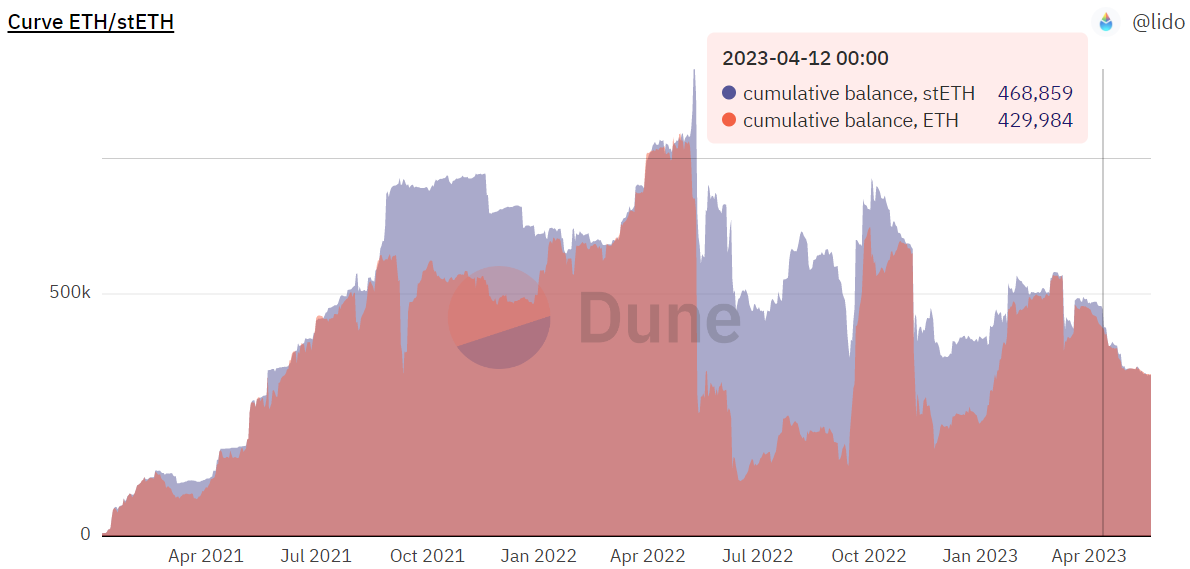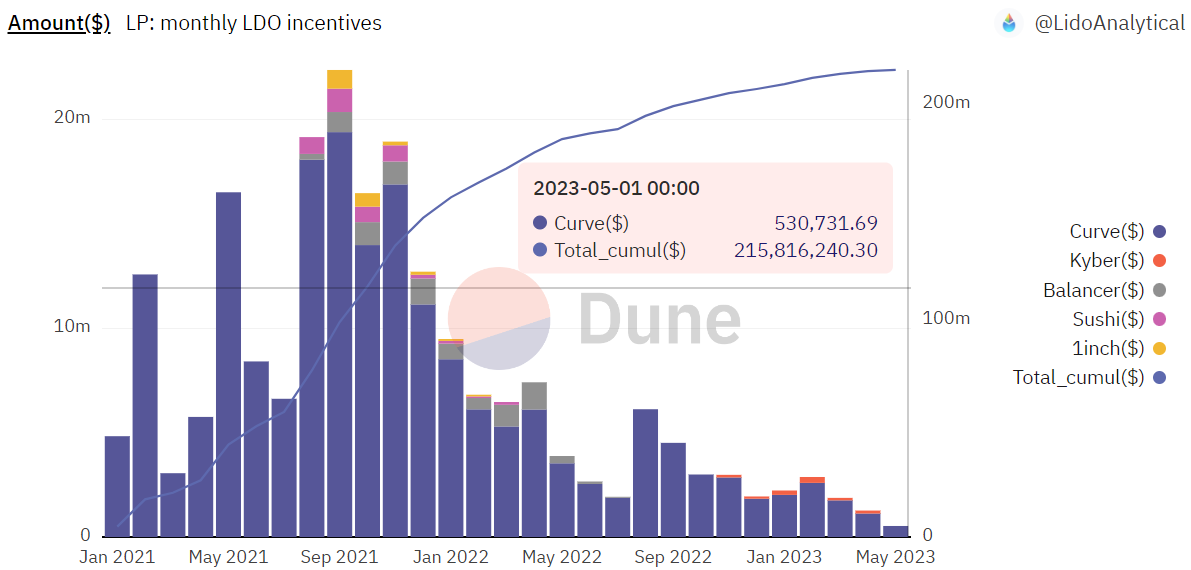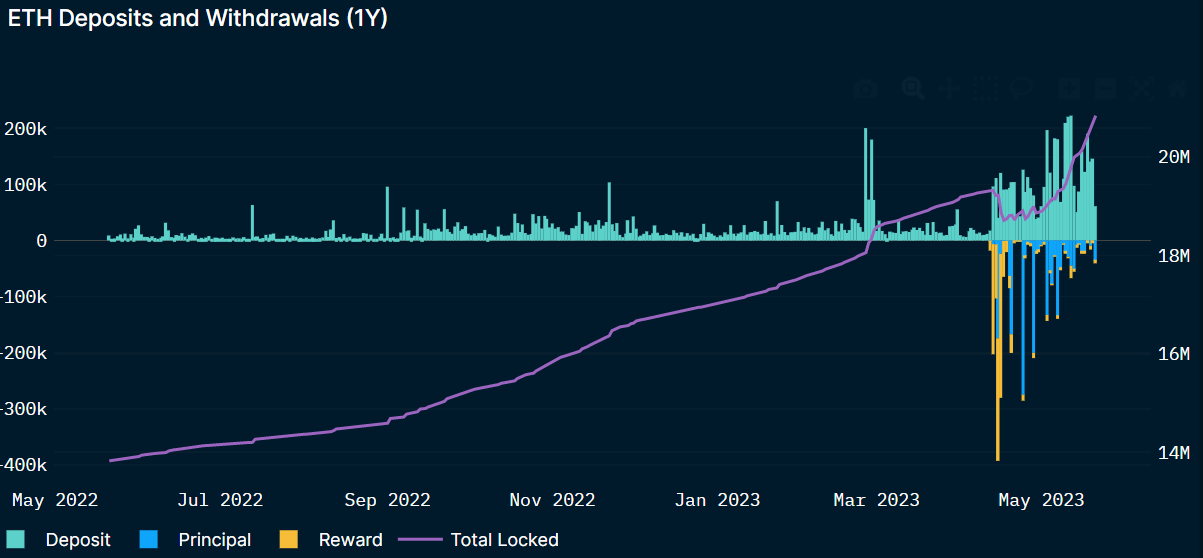Curve’s stETH-ETH Pool’s Liquidity Shrinks, Now Balanced

Since December 2020, Ethereum investors have been able to participate in the network’s staking mechanism, securing the network in the process. However, to stabilize this security, Ethereum developers decided to lock up these funds, until recently, on April 12th. This was when the much-appreciated Shapella upgrade occurred, unleashing liquidity gates.
However, from December 2020 to April 2023, DeFi platforms offered Ethereum users a way to circumvent the lock-up period – liquid staking. The three big ones are Lido, Rocket Pool, and Ankr. These platforms locked users’ ETH funds for them in exchange for receiving liquid staking tokens.
Liquidity Dominos Fall Into Place
In the case of Lido, this is stETH, equal to ETH value in a 1:1 ratio, but unlocked to be used across Ethereum’s many DeFi dApps for loans and yield farming. Lido is by far the largest liquid staking protocol, at $12,06 billion total value locked (TVL).

Lido cornered the market on Ethereum’s staking, at 31.3% marketshare. Image credit: Dune analytics via @hildobby
Conversely, Curve DeFi protocol is the largest liquidity source for stETH tokens to be used. Since the Shapella upgrade went live on April 12th, there has been a sharp drop in Curve’s stETH-ETH pool—the expected liquidity exit totals around $424.9 million.
- From 468,859 stETH to 331,891 stETH, a 29.21% decrease ($249.3 million)
- From 429,984 ETH to 333,483 ETH, a 22.4% decrease ($175.6 million)
However, it is also noticeable that the Curve stETH-ETH pool is now nearly perfectly balanced.

Since May 2022, the pool has become imbalanced in favor of stETH, and again in January this year. Image credit: Dune analytics via @Lido
With users holding both stETH and ETH in equal measure, this indicates that Lido rewards are still sufficient to entice liquid staking. These are issued by Lido DAO (decentralized autonomous organization) in the form of LDO token rewards.

Image credit: Dune analytics via @LidoAnalytical
Once again, just as Lido dominates liquid staking, Curve (blue) remains the go-to pool for monthly LDO incentives, further explaining the now-balanced stETH-ETH ratio.
What About Overall Ethereum Deposits?
Although Ethereum has become deflationary, at -0.307% since the Merge on September 15, 2022, ETH price has increased only 15%. However, ETH is up 51% YTD as the US banking crisis took the public spotlight and the Bitcoin rally reinvigorated the crypto market.
More importantly, when Shapella withdrawals were enabled, concerns about the liquidity death spiral turned invalid. Instead of selling pressure, more deposits took place. After some withdrawal sprees in April, the total amount of ETH locked is now higher than before the upgrade, at 20.8 million ETH (~$37.9 billion).

Image credit: Nansen.ai
Unfortunately, with popularity comes network congestion, which Ethereum is yet to tackle with the Surge upgrade that scales Ethereum with data sharding. Suffice it to say; for Ethereum to become the DeFi’s infrastructure for global mass adoption, its gas fees will have to be low and consistently so.






 Bitcoin
Bitcoin  Ethereum
Ethereum  Tether
Tether  USDC
USDC  TRON
TRON  Dogecoin
Dogecoin  Cardano
Cardano  Bitcoin Cash
Bitcoin Cash  Chainlink
Chainlink  Monero
Monero  LEO Token
LEO Token  Zcash
Zcash  Stellar
Stellar  Litecoin
Litecoin  Hedera
Hedera  Dai
Dai  Cronos
Cronos  Tether Gold
Tether Gold  OKB
OKB  Ethereum Classic
Ethereum Classic  KuCoin
KuCoin  Gate
Gate  Algorand
Algorand  Cosmos Hub
Cosmos Hub  VeChain
VeChain  Tezos
Tezos  Dash
Dash  TrueUSD
TrueUSD  Stacks
Stacks  IOTA
IOTA  Basic Attention
Basic Attention  Decred
Decred  Theta Network
Theta Network  NEO
NEO  Synthetix
Synthetix  Qtum
Qtum  Ravencoin
Ravencoin  DigiByte
DigiByte  0x Protocol
0x Protocol  Nano
Nano  Zilliqa
Zilliqa  Holo
Holo  Siacoin
Siacoin  Numeraire
Numeraire  Waves
Waves  BUSD
BUSD  Status
Status  Enjin Coin
Enjin Coin  Pax Dollar
Pax Dollar  Ontology
Ontology  Lisk
Lisk  Hive
Hive  Steem
Steem  Huobi
Huobi  OMG Network
OMG Network  NEM
NEM  Bitcoin Gold
Bitcoin Gold  Augur
Augur